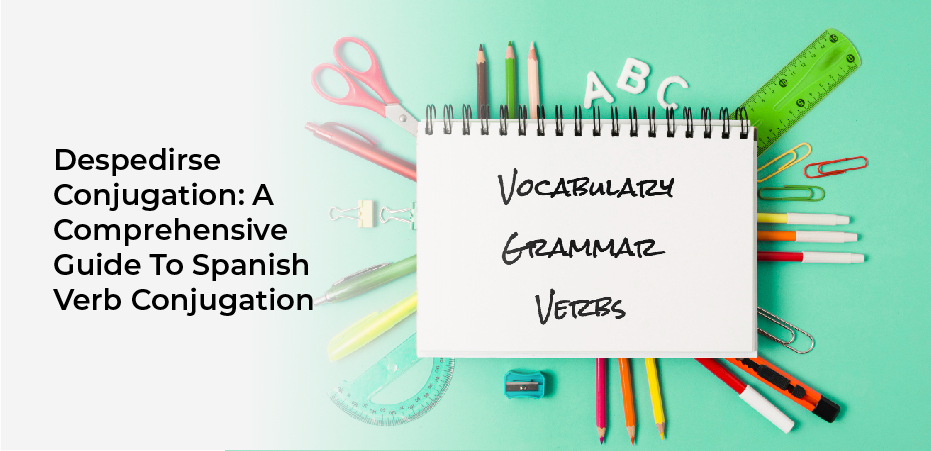If you’re learning Spanish, verb conjugation is one of the most important aspects to master. It can be tricky at first, but with practice, you’ll be able to correctly conjugate verbs without even thinking about it.
One verb that you’ll definitely want to learn is ‘despedirse’, which means ‘to say goodbye’. In this comprehensive guide, we’ll take a closer look at the conjugation of ‘despedirse’, so you can confidently use it in a variety of contexts.
Despedirse is a reflexive verb, which means it always needs a reflexive pronoun before the verb. This means that the verb changes depending on who is saying goodbye.
In this article, we’ll cover the present tense, past tense, and common usage of despedirse. You’ll learn how to use it in everyday conversation and be able to confidently say goodbye in Spanish.
So, let’s get started!
Understanding Spanish Verb Conjugation
You’ll quickly grasp the complexities of Spanish verb conjugation once you delve into the intricacies of the language. Understanding Spanish verb conjugation is essential if you want to communicate effectively with native Spanish speakers. It’s a fundamental part of the language that you must master if you wish to speak it fluently.
When you conjugate a verb, you change its form to match the person, tense, and mood of the sentence. Spanish has three moods: indicative, subjunctive, and imperative, and six tenses: present, future, imperfect, preterite, conditional, and present perfect.
Each tense has its own set of conjugations, which you must memorize to be able to use them correctly. Once you have a good understanding of the different tenses and moods, you’ll be able to form sentences that are grammatically correct and make sense.
Introduction to the Verb “Despedirse”
When you bid farewell, it’s like saying goodbye to a dear friend who you may not see for some time.
In Spanish, one of the verbs to express this sentiment is ‘despedirse.’ This verb is a reflexive verb, meaning it requires a reflexive pronoun before the verb. For example, instead of saying ‘I say goodbye,’ you would say ‘Me despido.’
To conjugate ‘despedirse’ in the present tense, you start by removing the ‘-se’ ending and then add the appropriate ending based on the subject pronoun.
For example, ‘Yo me despido’ means ‘I say goodbye to myself.’ Other forms include ‘Te despides’ (You say goodbye to yourself) and ‘Se despide’ (He/She/It says goodbye to himself/herself/itself).
As with all reflexive verbs, the pronoun changes to match the subject pronoun, and the verb must be conjugated accordingly.
Conjugating “Despedirse” in Present Tense
By removing the ending and adding the appropriate subject pronoun ending, the verb ‘despedirse’ transforms into a heartfelt farewell message.
In present tense, ‘despedirse’ is conjugated as follows:
- Yo me despido (I say goodbye)
- Tú te despides (You say goodbye)
- Él/Ella/Usted se despide (He/She/You formal say goodbye)
- Nosotros/Nosotras nos despedimos (We say goodbye)
- Vosotros/Vosotras os despedís (You all say goodbye, informal in Spain)
- Ellos/Ellas/Ustedes se despiden (They/You all say goodbye)
It’s important to remember that ‘despedirse’ is a reflexive verb, which means the subject of the sentence is also the object of the verb. This is why the reflexive pronouns ‘me’, ‘te’, ‘se’, ‘nos’, and ‘os’ are used before the verb.
So, when saying goodbye to someone, you would say ‘me despido’ instead of just ‘despido’.
Learning the conjugation of ‘despedirse’ in present tense is essential for anyone learning Spanish, especially if you plan on saying goodbye to someone in a respectful and sincere way.
Practice conjugating the verb and incorporating it into your daily conversations to become more fluent in the language.
Exploring Past Tense Conjugations
Exploring the past tense of a verb involves changing the verb’s ending to reflect the time frame of the action that took place. In the case of ‘despedirse’, it’s a reflexive verb, so the pronoun ‘se’ has to be added before the verb, and the ending has to be changed accordingly.
To conjugate ‘despedirse’ in the past tense, you have to use the auxiliary verb ‘haber’ in the present tense and add the past participle of ‘despedirse’, which is ‘despedido’.
For example, if you want to say ‘I said goodbye yesterday’, you would say ‘Me despedí ayer’. If you want to say ‘You said goodbye to your friends last week’, you would say ‘Te despediste de tus amigos la semana pasada’. As you can see, the ending of the verb changes depending on the subject pronoun and the time frame of the action.
It’s important to practice conjugating verbs in different tenses to become more comfortable and confident in speaking Spanish. In addition, it’s important to remember that there are different past tenses in Spanish, such as the preterite and the imperfect.
The preterite is used to describe completed actions in the past, while the imperfect is used to describe ongoing or repeated actions in the past. ‘Despedirse’ is commonly used in the preterite tense to describe a specific moment in the past when someone said goodbye.
By practicing different past tenses, you’ll be able to express yourself more accurately and effectively in Spanish.
Common Usage and Examples of “Despedirse”
Have you ever struggled with saying goodbye to someone in a foreign language? Let me tell you, mastering the proper way to bid farewell is crucial in Spanish-speaking countries!
One of the most common verbs used to say goodbye in Spanish is ‘despedirse’. This verb is commonly used in formal and informal situations and is a reflexive verb, meaning it requires a reflexive pronoun before the verb.
To conjugate ‘despedirse’, simply remove the ‘-se’ ending and add the appropriate reflexive pronoun and ending. For example, in the present tense, ‘yo me despido’ means ‘I say goodbye to myself’, ‘tú te despides’ means ‘you say goodbye to yourself’, and ‘él/ella/usted se despide’ means ‘he/she/you (formal) say goodbye to yourself’. In the past tense, ‘yo me despedí’ means ‘I said goodbye to myself’, ‘tú te despediste’ means ‘you said goodbye to yourself’, and ‘él/ella/usted se despidió’ means ‘he/she/you (formal) said goodbye to yourself’.
It’s important to note that ‘despedirse’ is not just used in the context of leaving someone physically. It can also mean ‘to say goodbye to a habit’, ‘to resign from a job’, and ‘to dismiss someone’.
So, the next time you find yourself bidding farewell to someone in a Spanish-speaking country, remember to use ‘despedirse’ and conjugate it properly according to the situation!
Frequently Asked Questions
What is the origin of the verb ‘despedirse’ and how has its usage evolved over time?
You may be curious about the origin and evolution of the verb ‘despedirse’. Over time, its usage has shifted from simply meaning ‘to take leave’ to also conveying a sense of saying goodbye with emotion and affection.
Are there any regional variations in the conjugation of ‘despedirse’?
“Are there regional variations in how ‘despedirse’ is conjugated?”Yes, there are. Depending on the region, you may encounter differences in the use of certain verb forms or pronouns.
What are some common mistakes that Spanish learners make when conjugating ‘despedirse’?
Common mistakes when conjugating ‘despedirse’ include forgetting the reflexive pronoun, using the wrong stem, and not accounting for regional variations. Remember to practice and study the correct forms for your intended audience.
Can ‘despedirse’ be used in formal or professional settings, or is it only appropriate for casual conversations?
You may use ‘despedirse’ in formal or professional situations, as it means ‘to say goodbye’ and is a common verb in Spanish. Just make sure to conjugate it appropriately based on the situation.
Are there any idiomatic expressions or phrasal verbs that use ‘despedirse’?
“You may be interested to know that there are several idiomatic expressions and phrasal verbs that use ‘despedirse’. One example is ‘despedirse de alguien’ which means to say goodbye to someone.”
Conclusion
So there you have it, a comprehensive guide to the Spanish verb conjugation of ‘despedirse’. We’ve covered the basics of Spanish verb conjugation, as well as delving deeper into the conjugation of ‘despedirse’ in both present and past tenses.
As a commonly used verb in Spanish, ‘despedirse’ is an important one to add to your vocabulary. Whether you’re saying goodbye to friends and family or simply ending a conversation, it’s a verb that’ll come in handy in many situations.
With the knowledge gained from this guide, you can confidently use ‘despedirse’ in your conversations and impress native Spanish speakers with your language proficiency. Keep practicing and soon you’ll be a pro at Spanish verb conjugation!


